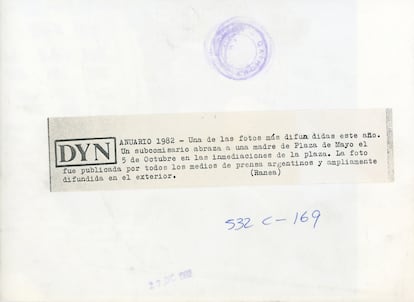The story behind a photograph that was exploited by Argentina’s military dictatorship
What appeared to be a moment of reconciliation between security forces and the mothers of disappeared children was, in fact, a heated confrontation

In the last months of Argentina’s military dictatorship (1976-1983), the junta used an emblematic photograph to whitewash their image. An alleged embrace between a police officer and a woman – one of the Mothers of the Plaza de Mayo – on October 5, 1982, was circulated by media outlets across the world, including EL PAÍS.
Years later, it came to light that, in reality, the woman in the photo – one of many searching for their missing children and grandchildren, who were disappeared by the military regime – was actually rebuking the officer, who was refusing to let her march. She threw herself at the policeman’s chest for a split second – a gesture captured by photographer Marcelo Ranea.
The regime subsequently endorsed the circulation of the photograph. 40 years later, however, six censored photographs in the archive of Télam – Argentina’s state news agency – have allowed us to reconstruct the farce put together by the military, which exhibited a moment of reconciliation that never took place.
The man who took the censored photos is Jorge Eduardo Sánchez. As a photographer for Télam – which was controlled by the dictatorship – he covered the March for Life. The rally, – attended by more than 10,000 people – was organized by several human rights organizations to demand answers about thousands of Argentinians who were forcibly disappeared by the junta during its years in power. The march was also meant to draw attention to the cases of thousands of political prisoners’ children, who were stolen and adopted out by the regime.
Fearing public humiliation and scrutiny, the Buenos Aires police banned the protest. They also closed off all access to the Plaza de Mayo. Of course, this did not deter thousands of mothers and grandmothers from marching.
One of Sánchez’s snapshots shows a row of uniformed men on horseback surrounding the protesters and dragging one woman away. In other photos, you can see several members of the Mothers of the Plaza de Mayo organization confronting Police Commissioner Carlos Enrique Gallone, demanding that he stop blocking their path. In one of the last shots, Susana de Leguía is seen crying with rage at the policeman’s refusal, with her hands raised towards him.
Sánchez returned to the newsroom and his negatives were reviewed by the director of Télam, Colonel Rafael de Piano. From his desk, without allowing for any dialogue, he yelled at the photographer: “This doesn’t have to be published. For your own good, let it go!”
Instead, Télam released an image taken by Ranea, a photographer for a competing news agency called DyN. It was accompanied by a headline reading “Demonstration takes place without incident,” falsely detailing that protesters had not been able to reach the Plaza de Mayo and that the gathering had ended without “riots or arrests.”

This “official version” was published in local and international media, accompanied by the powerful photograph. EL PAÍS printed the same image on its front page on October 8, 1982, sharing the false context:
“A police officer, in charge of repressing the mothers – who have been demanding answers about their disappeared loved ones for years – comforts one of the 10,000 people who participated in the March for Life.”
The following year, the photo was awarded the King of Spain Prize.
In 2008, Commissioner Gallone even used the award-winning photograph to support his defense case, when he was put on trial for the Fátima massacre. On August 20, 1976, some 30 detainees were extrajudicially executed by the Buenos Aires police, their bodies then dynamited. Gallone was ultimately sentenced to life in prison for crimes against humanity.
Sánchez kept a copy of one of the six censored photos he took. Two years ago, he posted it on his Facebook page. He also detailed how he had been kidnapped and transferred to a clandestine detention center, where he was subjected to “verbal and physical abuse” by the authorities, before being released hours later.
During his interview with EL PAÍS, Sánchez lamented how the photo distorted reality:
“A lie went around the world. I am hurt because the media – your outlet – published something without checking it first.”
Nora Cortiñas – co-founder of the Mothers of the Plaza de Mayo organization – has also confirmed the manipulation. “It was rare for this mother to come [to demonstrations] because she worked full-time. She didn’t know our code, which was to never touch a police officer. Susana’s gesture was one of desperation and fury,” she told Télam.
Ranea, the photographer who captured the fake hug, died last year. He, too, acknowledged that the image gave a distorted view of what had occurred.
“It was a fraction of a second during which Susana de Leguía and Commissioner Gallone confronted each other. She punches him in the chest and, to stop her hysteria, the guy held her in place for half-a-second at most. It was a very short interaction.”

The censored photographs were rescued as part of a project to enhance the Télam archive.
“We were doing a survey of photos of the Falklands War, reviewing uncatalogued material… and we found an envelope that read “March to the Plaza de Mayo, June 15, 1982,” says photographer Analía Garelli, coordinator of the archive’s enhancement. Argentina surrendered to Great Britain on June 14, which led to a couple of days of protests. That’s why she thought that the material stored there was related to the conflict.
“But when we opened the envelope, we found a single strip with six frames… I recognized one of them: it was the photo of Gallone and Susana de Leguía.”
Garelli explains that, while the images were censored, someone filed them under a different date, to prevent them from being easily located and destroyed. That decision ultimately saved the photos… but it still took 40 years for them to become public.
Tu suscripción se está usando en otro dispositivo
¿Quieres añadir otro usuario a tu suscripción?
Si continúas leyendo en este dispositivo, no se podrá leer en el otro.
FlechaTu suscripción se está usando en otro dispositivo y solo puedes acceder a EL PAÍS desde un dispositivo a la vez.
Si quieres compartir tu cuenta, cambia tu suscripción a la modalidad Premium, así podrás añadir otro usuario. Cada uno accederá con su propia cuenta de email, lo que os permitirá personalizar vuestra experiencia en EL PAÍS.
¿Tienes una suscripción de empresa? Accede aquí para contratar más cuentas.
En el caso de no saber quién está usando tu cuenta, te recomendamos cambiar tu contraseña aquí.
Si decides continuar compartiendo tu cuenta, este mensaje se mostrará en tu dispositivo y en el de la otra persona que está usando tu cuenta de forma indefinida, afectando a tu experiencia de lectura. Puedes consultar aquí los términos y condiciones de la suscripción digital.
Últimas noticias
Most viewed
- David King, chemist: ‘There are scientists studying how to cool the planet; nobody should stop these experiments from happening’
- Reinhard Genzel, Nobel laureate in physics: ‘One-minute videos will never give you the truth’
- Mexico completes its trade shift with the entry into force of tariffs on China and countries without trade agreements
- Oona Chaplin: ‘I told James Cameron that I was living in a treehouse and starting a permaculture project with a friend’
- Sinaloa Cartel war is taking its toll on Los Chapitos








































